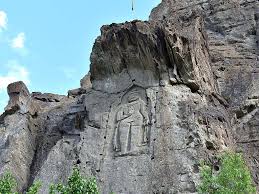The legendary Kargah Buddha is a 7th century Buddha figure carved deep into the solid rock. The three-meter (ten-foot) high imposing Buddha sculpture is located in Kargah Nullah (ravine) about 10km south of Gilgit town in Gilgit-Baltistan, Pakistan. There are a number of famous short outings from the town and an excursion to Kargah Buddha is unique and a must visit trip.
Gilgit is the capital town and administrative center of Gilgit-Baltistan, a mountainous region rich in the cultural and historic background. Strategically located at the intersection of ancient Silk Route, Gilgit has remained a major stopover for caravans making it a key trade center for centuries. The route passing through Gilgit is one of the several courses of the grand Silk Route – the extensive network of roads – connecting China in the east to Mediterranean in the west.
Besides trade of silk, spices and other goods, this network of routes has played a vital role in the transmission of cultures and religions as a result of interaction between the regions of China, Central Asia, Kashmir, Tibet, Afghanistan, Iran, and India. The introduction of a rich cultural heritage and spread of Buddhism in Gilgit and surrounding regions is deeply linked to the movement along the Silk Route. Historical facts reveal that religious Buddhist caravans used to stay in a monastery here while passing through Gilgit.
The Karakoram Highway (KKH), built mostly on the ancient silk route, is rich in rock art containing more than 10,000 images of Buddha, Stupas, animals, and carvings in more than ten languages suggest evolution and sovereignty of Buddhism in the region which lasted from 1st till 7th century A.D. Karga Buddha in Gilgit is also the part of rock art and reminiscent of Buddhist dominance in the region. It was believed that the image of Buddha was carved on the rock in order to pay tribute to Lord Buddha by performing religious rituals and worshipping.
Karga Buddha was discovered along with ruins of a Buddhist monastery and three stupas about 400 meters upriver from the Buddha itself in 1938-39 following the discovery of so-called Gilgit manuscripts in 1931. The manuscripts, written in Sanskrit, contain important information on the local rulers of the region and renowned pilgrims. It also features Buddhist text which testifies the existence of a learned community in the region. All the manuscripts found in the region between 1939 and 1956 have been moved and distributed to the British museum, and museums in Rome, Delhi, and Karachi.
There is yet another interesting myth about Karga Buddha devised by and famous amongst the local residents. According to the legend, once upon a time there lived an ogress called Yakhshini whom local people wanted to get rid of as it used to eat human flesh. The villagers asked a passing saint for help and the saint was said to have succeeded in pinning her to the rock. The series of whole making the boundary around the Buddha are actually believed pinhole holding ogress tight. Later the saint declared that she won’t bother them as long as the saint was alive. And if they buried the saint at the foothills of the rock, she would never be freed. The saint was said to have buried right below the Buddha statue.




Comment (0)